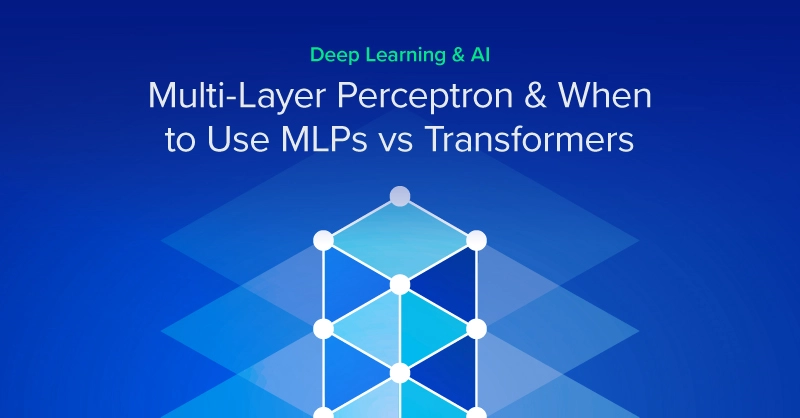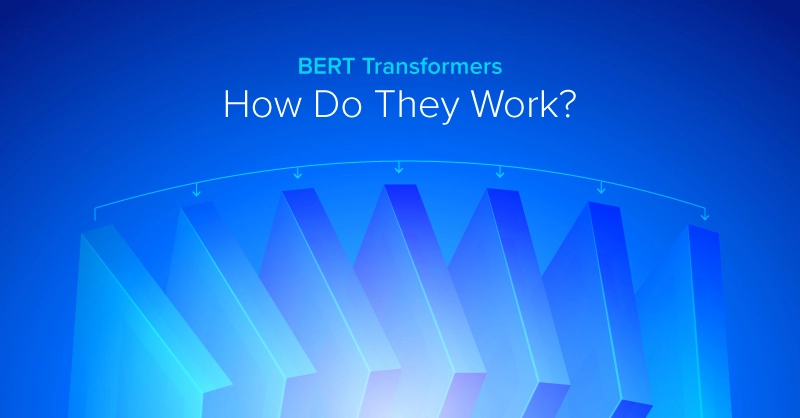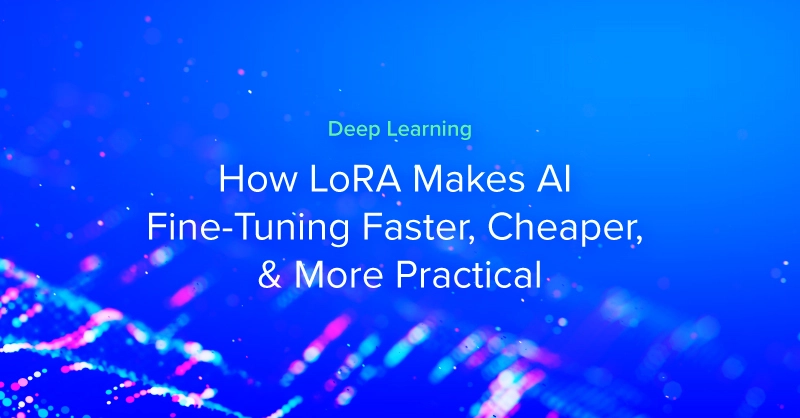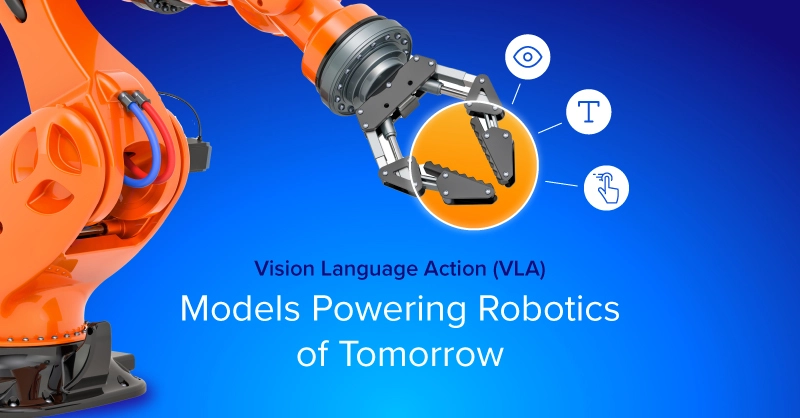
Introduction
Transformer models have dominated AI headlines recently, and their capabilities are truly impressive. And while generative AI and LLMs are being injected into every industry, it is important to realize they aren’t the universal solution for every AI challenge. A simpler Multi-Layer Perceptron neural network (MLPs) can prove to be more effective in specific use cases.
Traditional MLPs are the foundation of many modern deep learning systems. Their tried-and-true design can outperform more complex models on simpler everyday data problems, requiring fewer computational resources. We'll explore scenarios where MLPs are the superior choice over Transformers—that simplicity is an advantage.
What is a Multi-Layer Perceptron?
A Multi-Layer Perceptron (MLP) is one of the foundational architectures in neural networks and a key building block of most neural networks (including transformers). It’s a type of feedforward neural network consisting of multiple layers of nodes arranged in a sequence: an input layer, one or more hidden layers, and an output layer. Each node (or neuron) in a layer is connected to every node in the subsequent layer, which is why MLPs are often called fully connected networks.
What distinguishes MLPs from a basic single-layer perceptron is their ability to handle non-linear relationships by stacking multiple hidden layers and applying non-linear activation functions such as ReLU (Rectified Linear Unit), sigmoid, or tanh. These functions allow the network to learn complex patterns beyond simple linear separability.
Key Characteristics of MLPs:
- Feedforward architecture: Data flows in one direction—from input to output—without cycles or loops.
- Fully connected layers: Every neuron in one layer is connected to every neuron in the next.
- Backpropagation learning: Weights are updated through an optimization algorithm (commonly stochastic gradient descent) using the backpropagation of error.
- Activation functions: Non-linear functions inserted between layers to enable the network to approximate non-linear mappings.
Despite their simplicity, MLPs are powerful universal function approximators. Given sufficient depth and width, they can theoretically model any continuous function. However, this expressive power comes with trade-offs, particularly in terms of efficiency and inductive bias. MLPs lack the structural advantages found in architectures like CNNs or Transformers, which are specifically designed to exploit patterns in image or sequence data.
In practice, MLPs perform best on structured, tabular datasets where each input feature is independent and no spatial or sequential relationships exist. In these domains, the straightforward structure of an MLP often proves not only sufficient but superior due to its efficiency and ease of interpretation.
While MLPs may appear basic compared to today's advanced architectures, they remain widely used in real-world applications where their strengths align with the task at hand.
What are Transformers
Transformers are a more recent and advanced neural network architecture, most famous for powering LLMs and Generative AI. Unlike traditional feedforward networks like MLPs, Transformers are specifically designed to model relationships between elements in sequences, good for natural language processing, computer vision, and time series forecasting.
At the core of a Transformer is the attention mechanism, which allows the model to weigh the importance of different input elements relative to one another. Instead of processing data sequentially (as in MLPs), Transformers analyze input as a whole. This global context awareness is key to their performance on LLM tasks like translation, summarization, and question answering.
Transformers excel in unstructured data domains such as:
- Text: Language modeling, classification, summarization, and machine translation
- Vision: Image classification, object detection, and segmentation via Vision Transformers (ViTs)
- Multimodal Tasks: Combining text, image, and audio inputs in a single model
However, this flexibility comes at a cost. Transformers require significant compute resources, large amounts of training data, and careful hyperparameter tuning. For small or structured datasets, their complexity may be unnecessary or even counterproductive.
In summary, Transformers are powerful and versatile, especially for tasks involving complex context or relationships. But for real-world problems where data is structured and relatively simple, their overhead and prone to hallucinations may outweigh their benefits. MLPs might be the smarter choice for their lightweight and reliability.
When to Use MLPs vs Transformers
While Transformers dominate headlines for their capabilities in natural language and vision tasks, Multi-Layer Perceptrons (MLPs) often outperform them in specific, structured use cases. Simpler doesn't mean outdated—it means fit for purpose. Below are scenarios where MLPs are sufficient.
- Tabular Data: MLPs remain a top performer for structured, columnar data—think databases and spreadsheets. These datasets are common in industries like finance, healthcare, manufacturing, and retail, where each feature represents a distinct, well-defined variable. These industries often don’t have loads of data to train an effective transformer model, especially in healthcare, where external data is often protected.
- Transformers, which rely on learning relationships between tokens, offer limited advantage when features are independent or lack positional context.
- Studies and Kaggle competitions routinely show MLPs (sometimes paired with tree-based models like XGBoost) outperforming more complex neural architectures for these tasks.
- Small and Medium-Sized Datasets: Transformers typically shine when trained on millions or billions of data points. In contrast, MLPs generalize more effectively on smaller datasets due to fewer parameters and less risk of overfitting.
- In scenarios where labeled data is scarce or expensive to generate, MLPs can deliver competitive results without the overhead of deep pretraining.
- Their simplicity also makes hyperparameter tuning more straightforward.
- Real-Time and Low-Latency Inference: When deploying models to production systems—especially on edge devices or in latency-sensitive environments—MLPs are ideal due to their minimal computational requirements.
- MLPs are fast to load, lightweight in memory, and produce predictions in milliseconds.
- They're suitable for embedded systems, real-time decision-making, and mobile applications where power and resources are limited.
- Interpretability and Debuggability: MLPs are easier to interpret, monitor, and debug compared to deep Transformer architectures, which can be opaque and complex.
- In regulated industries like healthcare or finance, the ability to explain model behavior is critical.
- MLPs make it easier to understand the impact of individual features, which is essential for compliance, auditing, and trust.
Choosing the Right Tool: MLP vs Transformer
In the current AI landscape, it’s easy to default to the latest and most complex models, but architectural sophistication doesn’t always equate to practical superiority. Multi-Layer Perceptrons (MLPs) and Transformers serve different purposes, and understanding when to use each is key to building efficient, effective solutions.
MLPs excel in:
- Structured/tabular data environments
- Small to medium datasets
- Real-time or resource-constrained applications
- Scenarios demanding interpretability and rapid prototyping
Transformers are best for:
- Unstructured or high-dimensional data like text, images, and audio
- Large-scale datasets that benefit from attention-based learning
- Tasks requiring deep contextual understanding or long-range dependencies
| Criteria | Multi-Layer Perceptron (MLP) | Transformer |
| Data Type | Structured/tabular (Spreadsheets) | Unstructured (text, image, audio) |
| Dataset Size | Small to medium (approx. a million) | Large-scale (millions to billions of samples) |
| Model Complexity | Simple architecture with fewer parameters | Complex, multi-component architecture with high parameter count |
| Training Time & Resources | Fast training, minimal compute required | Requires GPUs/TPUs and large memory for efficient training |
| Interpretability | More interpretable; easier to trace feature impact | Difficult to interpret due to attention weights and deep stacking |
| Deployment Suitability | Ideal for edge devices and low-latency environments | Best for cloud deployment or compute-rich environments |
| Use Cases | Credit scoring, churn prediction, fraud detection, and other tasks that use structured tabular data. | Language modeling, translation, summarization, and vision tasks that require external context |
| Pretraining Dependency | Typically trained from scratch on the tabular data | Often requires pretraining on large corpora before fine-tuning |
| Best Fit For | Fast, lightweight inference on structured data | High-context understanding and pattern extraction in sequences/images |
Conclusion
In practical machine learning, especially when working with structured data, constrained resources, or real-time systems, Multi-Layer Perceptrons (MLPs) remain effective. They offer faster training, easier deployment, and sufficient performance for a wide range of applications—from financial scoring systems to powering certain aspects of recommendation engines like YouTube.
Ultimately, choosing between an MLP and a Transformer comes down to the nature of your data, the constraints of your application, and the goals of your model. In many cases, simpler architectures like MLPs not only suffice but outperform their larger counterparts, reminding us that in machine learning, “better” is always context-dependent.
With an agentic approach, a generative AI can employ suitable AI models like an MLP to tackle specific tabular data problems. This would be an interesting implementation of a hybrid approach where an agentic LLM can pass off specialized tasks to specialized ML models.
If your business or research operation is looking into expanding your computing infrastructure, Exxact has a wide range of customizable platforms to support your needs. Contact us today for a free quote and expert hardware configuration advice.
.png)
Fueling Innovation with an Exxact Multi-GPU Server
Training AI models on massive datasets can be accelerated exponentially with the right system. It's not just a high-performance computer, but a tool to propel and accelerate your research.
Configure Now
What are Multi-Layer Perceptrons and When to Use MLPs vs Transformers
Introduction
Transformer models have dominated AI headlines recently, and their capabilities are truly impressive. And while generative AI and LLMs are being injected into every industry, it is important to realize they aren’t the universal solution for every AI challenge. A simpler Multi-Layer Perceptron neural network (MLPs) can prove to be more effective in specific use cases.
Traditional MLPs are the foundation of many modern deep learning systems. Their tried-and-true design can outperform more complex models on simpler everyday data problems, requiring fewer computational resources. We'll explore scenarios where MLPs are the superior choice over Transformers—that simplicity is an advantage.
What is a Multi-Layer Perceptron?
A Multi-Layer Perceptron (MLP) is one of the foundational architectures in neural networks and a key building block of most neural networks (including transformers). It’s a type of feedforward neural network consisting of multiple layers of nodes arranged in a sequence: an input layer, one or more hidden layers, and an output layer. Each node (or neuron) in a layer is connected to every node in the subsequent layer, which is why MLPs are often called fully connected networks.
What distinguishes MLPs from a basic single-layer perceptron is their ability to handle non-linear relationships by stacking multiple hidden layers and applying non-linear activation functions such as ReLU (Rectified Linear Unit), sigmoid, or tanh. These functions allow the network to learn complex patterns beyond simple linear separability.
Key Characteristics of MLPs:
- Feedforward architecture: Data flows in one direction—from input to output—without cycles or loops.
- Fully connected layers: Every neuron in one layer is connected to every neuron in the next.
- Backpropagation learning: Weights are updated through an optimization algorithm (commonly stochastic gradient descent) using the backpropagation of error.
- Activation functions: Non-linear functions inserted between layers to enable the network to approximate non-linear mappings.
Despite their simplicity, MLPs are powerful universal function approximators. Given sufficient depth and width, they can theoretically model any continuous function. However, this expressive power comes with trade-offs, particularly in terms of efficiency and inductive bias. MLPs lack the structural advantages found in architectures like CNNs or Transformers, which are specifically designed to exploit patterns in image or sequence data.
In practice, MLPs perform best on structured, tabular datasets where each input feature is independent and no spatial or sequential relationships exist. In these domains, the straightforward structure of an MLP often proves not only sufficient but superior due to its efficiency and ease of interpretation.
While MLPs may appear basic compared to today's advanced architectures, they remain widely used in real-world applications where their strengths align with the task at hand.
What are Transformers
Transformers are a more recent and advanced neural network architecture, most famous for powering LLMs and Generative AI. Unlike traditional feedforward networks like MLPs, Transformers are specifically designed to model relationships between elements in sequences, good for natural language processing, computer vision, and time series forecasting.
At the core of a Transformer is the attention mechanism, which allows the model to weigh the importance of different input elements relative to one another. Instead of processing data sequentially (as in MLPs), Transformers analyze input as a whole. This global context awareness is key to their performance on LLM tasks like translation, summarization, and question answering.
Transformers excel in unstructured data domains such as:
- Text: Language modeling, classification, summarization, and machine translation
- Vision: Image classification, object detection, and segmentation via Vision Transformers (ViTs)
- Multimodal Tasks: Combining text, image, and audio inputs in a single model
However, this flexibility comes at a cost. Transformers require significant compute resources, large amounts of training data, and careful hyperparameter tuning. For small or structured datasets, their complexity may be unnecessary or even counterproductive.
In summary, Transformers are powerful and versatile, especially for tasks involving complex context or relationships. But for real-world problems where data is structured and relatively simple, their overhead and prone to hallucinations may outweigh their benefits. MLPs might be the smarter choice for their lightweight and reliability.
When to Use MLPs vs Transformers
While Transformers dominate headlines for their capabilities in natural language and vision tasks, Multi-Layer Perceptrons (MLPs) often outperform them in specific, structured use cases. Simpler doesn't mean outdated—it means fit for purpose. Below are scenarios where MLPs are sufficient.
- Tabular Data: MLPs remain a top performer for structured, columnar data—think databases and spreadsheets. These datasets are common in industries like finance, healthcare, manufacturing, and retail, where each feature represents a distinct, well-defined variable. These industries often don’t have loads of data to train an effective transformer model, especially in healthcare, where external data is often protected.
- Transformers, which rely on learning relationships between tokens, offer limited advantage when features are independent or lack positional context.
- Studies and Kaggle competitions routinely show MLPs (sometimes paired with tree-based models like XGBoost) outperforming more complex neural architectures for these tasks.
- Small and Medium-Sized Datasets: Transformers typically shine when trained on millions or billions of data points. In contrast, MLPs generalize more effectively on smaller datasets due to fewer parameters and less risk of overfitting.
- In scenarios where labeled data is scarce or expensive to generate, MLPs can deliver competitive results without the overhead of deep pretraining.
- Their simplicity also makes hyperparameter tuning more straightforward.
- Real-Time and Low-Latency Inference: When deploying models to production systems—especially on edge devices or in latency-sensitive environments—MLPs are ideal due to their minimal computational requirements.
- MLPs are fast to load, lightweight in memory, and produce predictions in milliseconds.
- They're suitable for embedded systems, real-time decision-making, and mobile applications where power and resources are limited.
- Interpretability and Debuggability: MLPs are easier to interpret, monitor, and debug compared to deep Transformer architectures, which can be opaque and complex.
- In regulated industries like healthcare or finance, the ability to explain model behavior is critical.
- MLPs make it easier to understand the impact of individual features, which is essential for compliance, auditing, and trust.
Choosing the Right Tool: MLP vs Transformer
In the current AI landscape, it’s easy to default to the latest and most complex models, but architectural sophistication doesn’t always equate to practical superiority. Multi-Layer Perceptrons (MLPs) and Transformers serve different purposes, and understanding when to use each is key to building efficient, effective solutions.
MLPs excel in:
- Structured/tabular data environments
- Small to medium datasets
- Real-time or resource-constrained applications
- Scenarios demanding interpretability and rapid prototyping
Transformers are best for:
- Unstructured or high-dimensional data like text, images, and audio
- Large-scale datasets that benefit from attention-based learning
- Tasks requiring deep contextual understanding or long-range dependencies
| Criteria | Multi-Layer Perceptron (MLP) | Transformer |
| Data Type | Structured/tabular (Spreadsheets) | Unstructured (text, image, audio) |
| Dataset Size | Small to medium (approx. a million) | Large-scale (millions to billions of samples) |
| Model Complexity | Simple architecture with fewer parameters | Complex, multi-component architecture with high parameter count |
| Training Time & Resources | Fast training, minimal compute required | Requires GPUs/TPUs and large memory for efficient training |
| Interpretability | More interpretable; easier to trace feature impact | Difficult to interpret due to attention weights and deep stacking |
| Deployment Suitability | Ideal for edge devices and low-latency environments | Best for cloud deployment or compute-rich environments |
| Use Cases | Credit scoring, churn prediction, fraud detection, and other tasks that use structured tabular data. | Language modeling, translation, summarization, and vision tasks that require external context |
| Pretraining Dependency | Typically trained from scratch on the tabular data | Often requires pretraining on large corpora before fine-tuning |
| Best Fit For | Fast, lightweight inference on structured data | High-context understanding and pattern extraction in sequences/images |
Conclusion
In practical machine learning, especially when working with structured data, constrained resources, or real-time systems, Multi-Layer Perceptrons (MLPs) remain effective. They offer faster training, easier deployment, and sufficient performance for a wide range of applications—from financial scoring systems to powering certain aspects of recommendation engines like YouTube.
Ultimately, choosing between an MLP and a Transformer comes down to the nature of your data, the constraints of your application, and the goals of your model. In many cases, simpler architectures like MLPs not only suffice but outperform their larger counterparts, reminding us that in machine learning, “better” is always context-dependent.
With an agentic approach, a generative AI can employ suitable AI models like an MLP to tackle specific tabular data problems. This would be an interesting implementation of a hybrid approach where an agentic LLM can pass off specialized tasks to specialized ML models.
If your business or research operation is looking into expanding your computing infrastructure, Exxact has a wide range of customizable platforms to support your needs. Contact us today for a free quote and expert hardware configuration advice.
.png)
Fueling Innovation with an Exxact Multi-GPU Server
Training AI models on massive datasets can be accelerated exponentially with the right system. It's not just a high-performance computer, but a tool to propel and accelerate your research.
Configure Now



.jpg?format=webp)